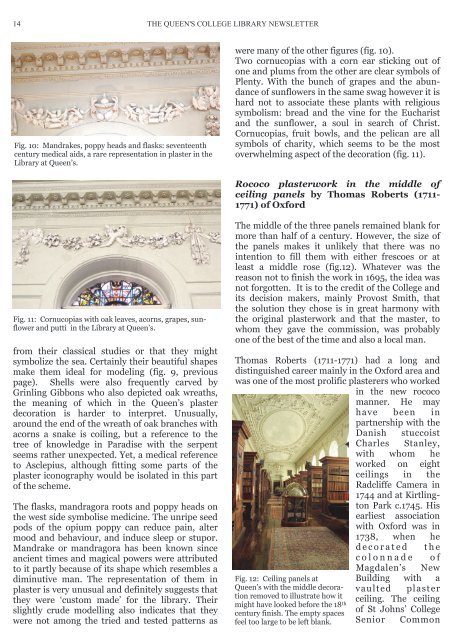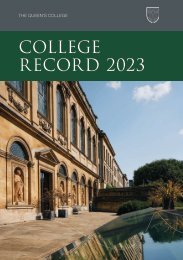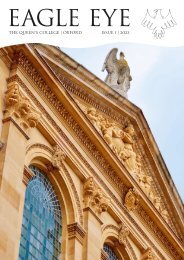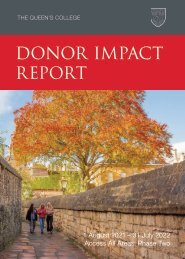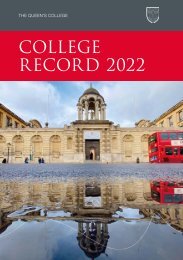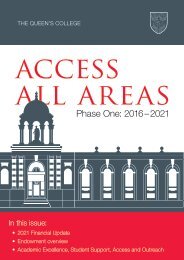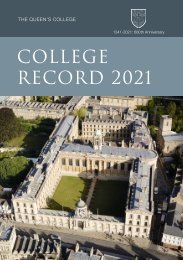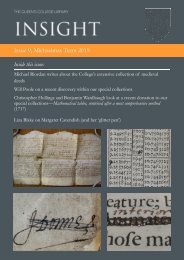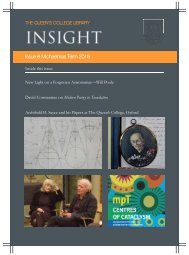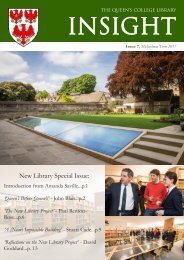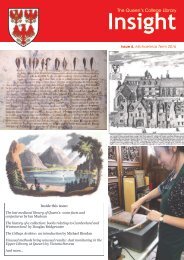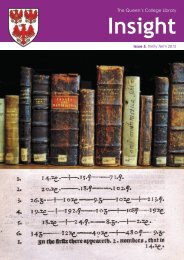You also want an ePaper? Increase the reach of your titles
YUMPU automatically turns print PDFs into web optimized ePapers that Google loves.
14<br />
THE QUEEN'S COLLEGE LIBRARY NEWSLETTER<br />
Fig. 10: Mandrakes, poppy heads and flasks: seventeenth<br />
century medical aids, a rare representation in plaster in the<br />
Library at Queen’s.<br />
were many of the other figures (fig. 10).<br />
Two cornucopias with a corn ear sticking out of<br />
one and plums from the other are clear symbols of<br />
Plenty. With the bunch of grapes and the abundance<br />
of sunflowers in the same swag however it is<br />
hard not to associate these plants with religious<br />
symbolism: bread and the vine for the Eucharist<br />
and the sunflower, a soul in search of Christ.<br />
Cornucopias, fruit bowls, and the pelican are all<br />
symbols of charity, which seems to be the most<br />
overwhelming aspect of the decoration (fig. 11).<br />
Rococo plasterwork in the middle of<br />
ceiling panels by Thomas Roberts (1711-<br />
1771) of Oxford<br />
Fig. 11: Cornucopias with oak leaves, acorns, grapes, sunflower<br />
and putti in the Library at Queen’s.<br />
from their classical studies or that they might<br />
symbolize the sea. Certainly their beautiful shapes<br />
make them ideal for modeling (fig. 9, previous<br />
page). Shells were also frequently carved by<br />
Grinling Gibbons who also depicted oak wreaths,<br />
the meaning of which in the Queen’s plaster<br />
decoration is harder to interpret. Unusually,<br />
around the end of the wreath of oak branches with<br />
acorns a snake is coiling, but a reference to the<br />
tree of knowledge in Paradise with the serpent<br />
seems rather unexpected. Yet, a medical reference<br />
to Asclepius, although fitting some parts of the<br />
plaster iconography would be isolated in this part<br />
of the scheme.<br />
The flasks, mandragora roots and poppy heads on<br />
the west side symbolise medicine. The unripe seed<br />
pods of the opium poppy can reduce pain, alter<br />
mood and behaviour, and induce sleep or stupor.<br />
Mandrake or mandragora has been known since<br />
ancient times and magical powers were attributed<br />
to it partly because of its shape which resembles a<br />
diminutive man. The representation of them in<br />
plaster is very unusual and definitely suggests that<br />
they were ‘custom made’ for the library. Their<br />
slightly crude modelling also indicates that they<br />
were not among the tried and tested patterns as<br />
The middle of the three panels remained blank for<br />
more than half of a century. However, the size of<br />
the panels makes it unlikely that there was no<br />
intention to fill them with either frescoes or at<br />
least a middle rose (fig.12). Whatever was the<br />
reason not to finish the work in 1695, the idea was<br />
not forgotten. It is to the credit of the College and<br />
its decision makers, mainly Provost Smith, that<br />
the solution they chose is in great harmony with<br />
the original plasterwork and that the master, to<br />
whom they gave the commission, was probably<br />
one of the best of the time and also a local man.<br />
Thomas Roberts (1711-1771) had a long and<br />
distinguished career mainly in the Oxford area and<br />
was one of the most prolific plasterers who worked<br />
in the new rococo<br />
manner. He may<br />
have been in<br />
partnership with the<br />
Danish stuccoist<br />
Charles Stanley,<br />
with whom he<br />
worked on eight<br />
ceilings in the<br />
Radcliffe Camera in<br />
1744 and at Kirtlington<br />
Park c.1745. His<br />
earliest association<br />
with Oxford was in<br />
1738, when he<br />
d e c o r a t e d t h e<br />
c o l o n n a d e o f<br />
Magdalen’s New<br />
Fig. 12: Ceiling panels at<br />
Queen’s with the middle decoration<br />
removed to illustrate how it<br />
might have looked before the 18 th<br />
century finish. The empty spaces<br />
feel too large to be left blank.<br />
Building with a<br />
vaulted plaster<br />
ceiling. The ceiling<br />
of St Johns’ College<br />
Senior Common


